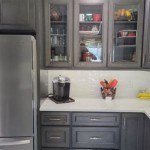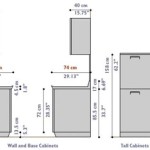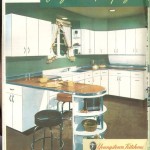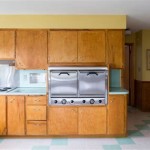Before And After: Kitchen Cabinets Painted Black
Repainting kitchen cabinets can dramatically transform the aesthetic of a kitchen, often at a fraction of the cost of a complete remodel. One particularly impactful choice is using black paint. Black cabinets offer a sophisticated, modern, and sometimes dramatic look that can be adapted to a wide range of kitchen styles. This exposition will explore before-and-after examples of kitchen cabinets painted black, analyzing the transformative effects and discussing key considerations for undertaking such a project.
Visual evidence provides compelling support for the effectiveness of black cabinet paint. In numerous instances, kitchens with dated, light-colored, or simply uninspired cabinets have been revitalized with a coat of black paint. These transformations frequently involve updating hardware, countertops, and backsplashes to complement the new cabinet color, resulting in a completely refreshed space.
A primary advantage of painting cabinets black is its ability to create a focal point. In a kitchen, cabinets occupy a significant amount of visual space. By painting them black, one strategically draws the eye, anchoring the room and establishing a clear design direction. This is particularly effective in larger kitchens or those with high ceilings, where black cabinets can help to ground the space and prevent it from feeling too airy or disjointed.
The versatility of black as a color also contributes to its popularity. Black cabinets can be paired with a wide range of colors and materials. For a modern and minimalist look, black cabinets can be combined with white countertops and stainless steel appliances. For a more traditional or farmhouse-inspired aesthetic, black cabinets can be paired with butcher block countertops, warm wood accents, and vintage-style hardware. The adaptability of black allows it to seamlessly integrate into diverse design schemes.
Many before-and-after examples showcase the impact of black paint on outdated oak cabinets. Oak cabinets, often characterized by their prominent grain, can appear dated or overwhelming in lighter wood tones. Painting them black effectively conceals the grain pattern, creating a smoother, more uniform surface. This immediately modernizes the cabinets, transforming them from a design liability into a design asset.
Another common transformation involves kitchens with builder-grade cabinets. These cabinets, often made from inexpensive materials and finished with a simple, unremarkable paint or stain, can benefit significantly from a fresh coat of black paint. The dark color adds depth and sophistication, elevating the overall appearance of the cabinets and making them appear more expensive and custom-designed.
Key Point 1: Achieving A Modern Aesthetic
One of the most significant benefits of painting kitchen cabinets black is the instant modernization it provides. Observe a kitchen with honey-oak cabinets, frequently found in homes built in the late 20th century. The before picture typically presents a space that feels warm, but also dated and somewhat visually heavy due to the pronounced wood grain. The after photo, showcasing the same cabinets painted a satin or matte black, reveals a completely transformed space. The grain is less noticeable, the room feels sleeker, and the overall impression is significantly more contemporary. The addition of new, modern hardware, such as simple brushed nickel pulls, further enhances the updated aesthetic.
Consider a kitchen with light-colored, shaker-style cabinets. While these cabinets are inherently versatile, a light color palette can sometimes feel bland or uninspired. Painting these cabinets black introduces a sense of drama and sophistication. The contrast between the black cabinets and a light-colored backsplash, such as white subway tile, creates visual interest and depth. Stainless steel appliances and minimalist decor complete the modern look, resulting in a kitchen that feels both stylish and functional.
The choice of black paint itself plays a crucial role in achieving a modern aesthetic. Matte or satin finishes are generally preferred over glossy finishes, as they tend to appear more sophisticated and less likely to show imperfections. A high-quality paint specifically designed for cabinets is essential to ensure a durable and long-lasting finish. Proper preparation, including thorough cleaning, sanding, and priming, is also critical for achieving a professional-looking result.
Key Point 2: The Importance of Hardware and Countertops
While the black paint is the primary transformative element, the selection of hardware and countertops is equally important in achieving a successful kitchen cabinet makeover. Outdated hardware can detract from the overall impact of the black cabinets, while mismatched or poorly chosen countertops can create a jarring visual effect.
Imagine a kitchen with black cabinets and existing brass hardware. While brass can be a beautiful accent material, it may not always complement black cabinets, particularly if the brass is dated or tarnished. Replacing the brass hardware with sleek, modern pulls in brushed nickel, stainless steel, or matte black can create a more cohesive and contemporary look. The choice of hardware should reflect the overall style of the kitchen and complement the black cabinets without overpowering them.
Countertops play a crucial role in creating a balanced and harmonious kitchen design. Pairing black cabinets with light-colored countertops, such as white quartz or marble, creates a striking contrast that brightens the space and prevents it from feeling too dark. Alternatively, pairing black cabinets with dark countertops, such as black granite or soapstone, creates a more dramatic and moody aesthetic. The key is to consider the overall lighting in the kitchen and choose countertops that complement the black cabinets without making the space feel too cramped or overwhelming.
In many before-and-after examples, the countertop material is upgraded from laminate to a more durable and aesthetically pleasing option, such as granite or quartz. This upgrade, combined with the black cabinet paint, dramatically transforms the look and feel of the kitchen, creating a more luxurious and high-end appearance.
Key Point 3: Lightening the Surrounding Space is Essential
Painting kitchen cabinets black can introduce a sense of drama and sophistication, but it's crucial to consider the overall lighting and surrounding elements to prevent the space from feeling too dark or claustrophobic. Effectively lightening the surrounding spaces becomes essential to a successful transformation.
Observe a kitchen entirely clad in dark colors, including dark floors, dark countertops, and dark walls. Painting the cabinets black in such a space could exacerbate the darkness, creating an oppressive and uninviting atmosphere. In such cases, it's crucial to lighten the other elements of the kitchen to balance the darkness of the cabinets.
This can be achieved by painting the walls a light color, such as white, off-white, or a light gray. These colors reflect light, brightening the space and creating a sense of openness. Installing a light-colored backsplash, such as white subway tile or a glass mosaic, can further enhance the brightness of the kitchen. Ample lighting, including under-cabinet lighting, recessed lighting, and pendant lights, is also essential to illuminate the space and prevent it from feeling too dark.
Consider a kitchen with black cabinets and dark hardwood floors. While dark hardwood floors can be beautiful, they can also contribute to a darker overall aesthetic. Introducing a light-colored rug or runner can help to break up the darkness and add visual interest to the space. Light-colored accessories, such as dishes, canisters, and artwork, can also help to brighten the kitchen and prevent it from feeling too heavy or monochromatic.
Natural light plays a crucial role in the overall brightness of a kitchen. Maximizing natural light by keeping windows clean and free from obstructions is essential. If natural light is limited, consider adding more artificial light sources to compensate. The goal is to create a balanced and well-lit space that feels both stylish and inviting, despite the presence of black cabinets.
The transformation from drab to dramatic is often evident in before-and-after photographs. Dated kitchens often lack sufficient lighting, contributing to a dull and uninviting atmosphere. In many cases, the after photos reveal the addition of recessed lighting, under-cabinet lighting, and pendant lights, which dramatically brighten the space and highlight the beauty of the black cabinets. The improved lighting not only enhances the aesthetic appeal of the kitchen but also improves its functionality and usability.
Beyond the immediate effects of the paint, the success of a black cabinet transformation hinges on careful attention to detail. Surface preparation is paramount. Cabinets must be thoroughly cleaned, degreased, and sanded to create a smooth, receptive surface for the primer and paint. The selection of high-quality paint is crucial, as inferior paints may chip, peel, or fade over time. Multiple thin coats of paint are preferred over a single thick coat, as this helps to prevent drips and ensures a more even and durable finish.
Furthermore, the hardware selected for the cabinets should complement the black finish and the overall design aesthetic. Modern, minimalist hardware in brushed nickel or stainless steel often works well with black cabinets, while more traditional styles may require a different approach. The size and placement of the hardware should also be carefully considered to ensure that it is both functional and aesthetically pleasing.
Finally, the surrounding elements of the kitchen, such as the countertops, backsplash, and flooring, must be carefully coordinated with the black cabinets to create a cohesive and harmonious design. Light-colored countertops and backsplashes can help to brighten the space and create a striking contrast with the black cabinets, while darker options can create a more dramatic and moody effect. The flooring should also be chosen to complement the cabinets and the overall style of the kitchen.

Wood And Black Kitchen Cabinets Jennifer Rizzo

Top 5 Things To Know When Painting Your Kitchen Cabinets In 2024 Black Decor Distressed

Before And After Primitive Kitchen Painted Black Cabinets Diy Makeover Renovation Painting

16 Kitchen Design Ideas For Black Cabinets Lily Ann

Distressing Kitchen Cabinets Before And After Primitive Style Color Black Paint Budget Remodel Cabinet Colors

Sleek Dark Chocolate Painted Cabinets Kitchen Diy Makeover Home House Design

Dare You To Paint Your Cabinets Black Emily P Freeman

Before After Black Kitchen Cabinets Breakfast Room Heather Scott Home Design

Wood And Black Kitchen Cabinets Jennifer Rizzo

Scrap Ali Ever After Black Painted Kitchen Cabinets
Related Posts








